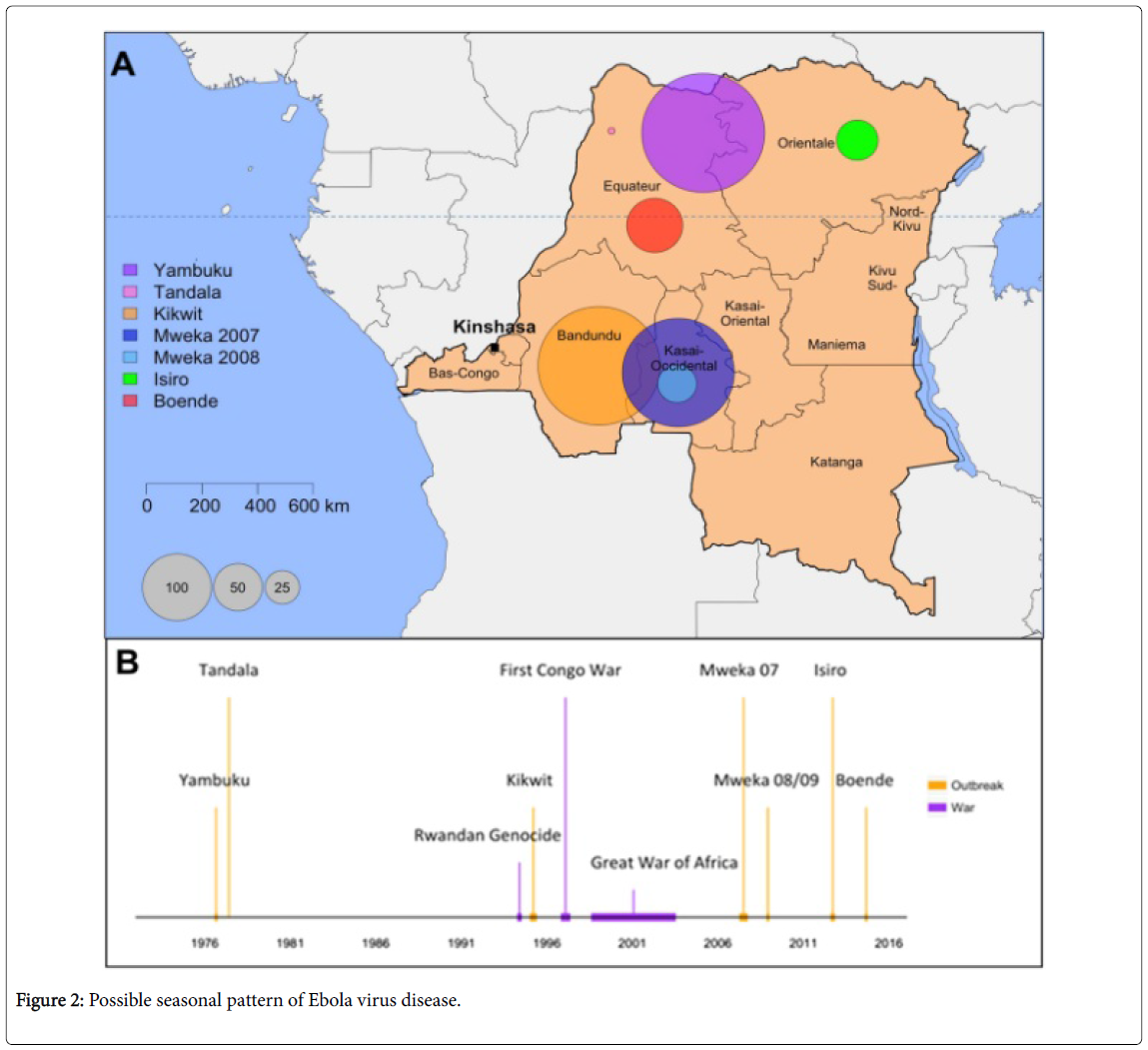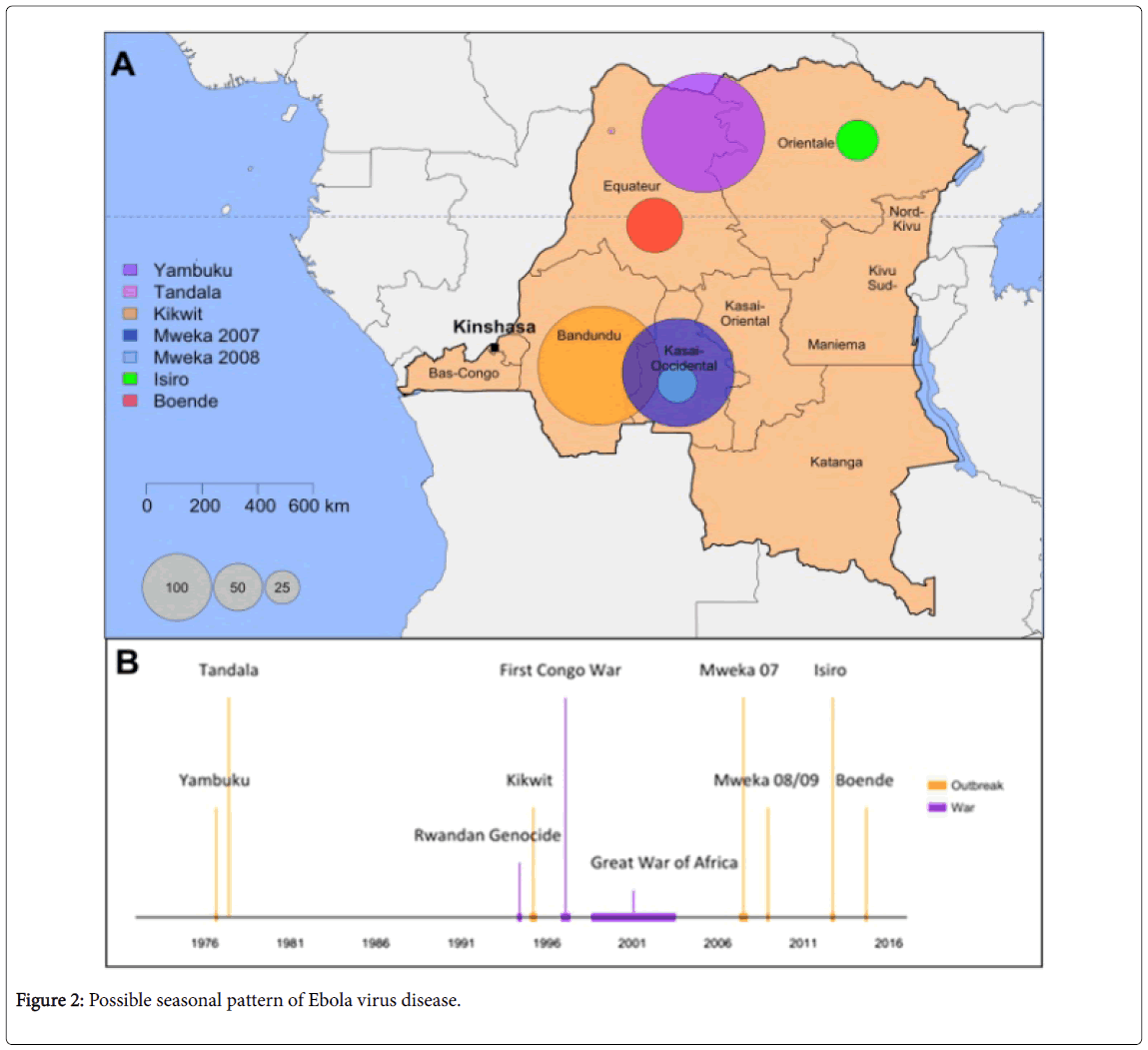Possible Seasonal Pattern of Ebola Virus Disease in the Democratic Republic of the Congo
Received: 06-Apr-2016 / Accepted Date: 17-May-2016 / Published Date: 24-May-2016 DOI: 10.4172/2161-1165.1000245
Abstract
The Democratic Republic of the Congo has two seasons (dry and rain). However this allocation across the country is totally different in terms of length. First, in the north of Equator, the rainy seasons start from April until the end of June then from September to the end of October. The dry seasons start from the beginning of November until the end of March (called the major dry season) and the beginning of July until the end of August (the minor dry season). Second, in the south of Equator, the rhythm of seasons is exactly inversed. The rainy season starts from October to May and the dry season (mid-May until the end of September). Rains are almost constant along the year.
Keywords: Ebola virus disease, Democratic Republic of the Congo, Dry season, Equator
164346Introduction
Based on available documents from the direction responsible of outbreaks in DR Congo, the country experienced since 1976 seven recognized Ebola outbreaks, 3 out of 7 occurred in the North of Equator (Yambuku (Bumba), Isiro and Djera) and 4 out of 7 occurred in the South of Equator (Kikwit, Cuvette Ouest, Mweka 1 and 2 and Luebo).
The 1st outbreak (Yambuku, Bumba) from September 1976 to October 1976 coincide with the rainy season.
The 2nd outbreak (Kikwit) occurred over decade from the first outbreak, this deadly outbreak occurred from January 1995-July 1995 which matches with both seasons.
Author emphasized that the outbreak started during the rainy season then continued in dry season, with a slight different in terms of mortality (higher during rainy season compared to the dry season) (Figure 1).
The 3rd outbreak (Cuvette Ouest), from December 2002 to December 2003 is the longest outbreak observed in DR Congo but with less lethality compared to the Kikwit episode. Like the second outbreak, it’s covered both seasons.
The 4th outbreak (Mweka 1 and 2), from May 2007 to October 2007. The first outbreak (Mweka 1) occurred during the dry season and last until the rainy season. From November 2008 to January 2009, Ebola resurfaced in the same region (Mweka 2), as we can see it occurred during the rainy season.
The 5th outbreak (Luebo), occurred during the same period with the Mweka 2, both outbreaks are linked since the distance between Mweka and Luebo is 36 miles.
The 6th outbreak (Isiro) from August 2012 to October 2012 matches the period starting from the minor dry season to the rainy season.
The 7th outbreak (Djera), the last one, from August 2014 to November occurred during the minor dry season then continued during the rainy season prior ending the major dry season (Figure 2).
The onset of these outbreaks appeared to be linked with higher absolute humidity and lower temperature (23 degree Celsius for DRC) if we consider the parameter of time [1].
Seasons have possibly an impact in the trend of outbreaks related to the EVD, in the north of Equator, 2 out 3 outbreaks started during the dry season, except from the first outbreak (Yambuku in 1976) which occurred during the rainy season; and in the south of Equator, 4 out 4 outbreaks started during the rainy season (except the outbreak of Mweka 1 who started during the dry season).
Conclusion
Even though, the occurrence of Ebola Virus Disease is closely bind to ecological factors, to date there is no clear evidence of Ebola seasonality in DRC, even if it is clear that seasons have an impact on our behaviors, further studies will be required to determine the association between seasons and Ebola Virus Disease in DRC.
References
- Rosello A, Mossoko M, Flasche S, Hoek AJV, Mbala P (2015) Ebola virus disease in the Democratic Republic of the Congo, 1976-2014. eLife digest 4: e09015.
Citation: Elenge DM (2016) Possible Seasonal Pattern of Ebola Virus Disease in the Democratic Republic of the Congo. Epidemiology (Sunnyvale) 6:245. DOI: 10.4172/2161-1165.1000245
Copyright: © 2016 Elenge DM. This is an open-access article distributed under the terms of the Creative Commons Attribution License, which permits unrestricted use, distribution, and reproduction in any medium, provided the original author and source are credited.


